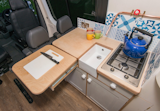“The pull-out drawer at the rear is a very large and sturdy storage space that can actually support my weight (although a bit scary) and was intended to be just stowage space really,” he says. “Once it was installed and we pulled it out, we discovered it was a great height for sitting at. And then the idea of a rather elaborate outdoor kitchen came up.”
“The details, such as the fine joinery and fancy bits, took a while longer to get right,” says Richens, who custom-built every detail down to the silverware boxes. “The custom cutlery tray inserts were made to measure to fit the drawers. It was a bit of a flight of fancy, but once you're down the rabbit hole, you may as well keep going."
“Segovia is a very central region, but an underdeveloped one,” de la Quadra-Salcedo says. “Traditionally devoted to agriculture and mainly livestock, it flourished in the sixteenth century but now that the older generations are disappearing, there is a problem of abandoned villages and fields.” The structure highlights the rural surroundings.
For Gabriel Ramirez and his partner Sarah Mason Williams, following the Sea Ranch rules—local covenants guide new designs—didn’t mean slipping into Sea Ranch clichés. The architects love Cor-Ten steel, with its ruddy and almost organic surface, and they made it the main exterior material, along with board-formed concrete and ipe wood. The Cor-Ten, which quickly turned an autumnal rust in the sea air, and the concrete, with its grain and crannies, mean the house isn’t a pristine box, Ramirez says. His Neutra house “was very crisp and clean,” he says. “This house is more distressed, more wabi-sabi.”
The bank of windows on the rear facade faces a lush hillside. "The prototypical country house wants to look over and out on the land," says Rappe. "This house looks at the slope upward. It makes for a different sense of space." Rappe was very careful to ensure that the house would not be visible from the existing properties and that neighboring houses would not be visible from within his design. "We wanted to do a home that was attractive to our clients but not too obtrusive to neighbors," he adds. "We wanted to be good modernists."
The architects designed the rooms as a linear sequence wrapping around a central courtyard. As one would have traversed the preexisting rock face, residents are constantly negotiating small elevation changes throughout the house. The plan also protects a central courtyard from the harsh Yucca Valley climate.
Finished in 2013, the 3,660-square-foot Casa Incubo was built from stacking and sliding four shipping containers to create a residence and gallery for photographer Sergio Pucci (who took all the photos of his new home). Set on flat ground, the two-story structure ended up being much easier for architect Maria Jose Trejos to complete than a typically constructed home, saving roughly 20 percent of the cost of a standard concrete block design.


























